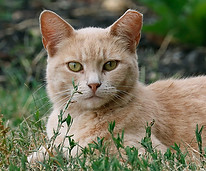What We Do
CATSS helps care for and control the feral cat population through the process of trapping-neutering-returning. TNR is recommended only for colonies of feral cats who can be returned to supervised sites where long-term care can be assured.
1
Trapping
Working along side the Oberlin Community, CATSS searches for new feral and stray cats who need to be medically assisted, returned to their home, or given a forever home through adoption.

What is a feral cat?
A feral cat is a cat who has either never had any contact with people or their contact with people has diminished over time. She is not socialized to people and survives on her own outdoors.
Stray vs. feral cats
Stray cats are socialized to people and can be adopted into homes, but feral cats are not socialized to people and are happy living outdoors.
How does CATSS help cats?
CATSS cares for feral and stray cats and kittens in the Oberlin, OH area. Through trapping, neutering, and returning cats, we work to keep the cat community healthy and controlled.
2
Spaying and
neutering


Spaying and neutering colonies of cats benefits the community because it:
Humanely traps all cats in a colony.
Transports the cat to a veterinarian for sterilization, ear tipped and vaccinations.
Returns the cats to their original colony site where they are monitored by fosters.
Stabilizes the population at managible levels.
Eliminates "annoying" behaviors associated with mating (fighting, yowling, spraying toms," etc.).
Helps make the animals easier to deal with over the long term (e.g. trapping for future veterinary treatment).
Is more effective and less costly than repeated attempts at eradication which only create space for further strays to enter the territory.
Is humane to the animals and fosters compassion in the community.
Look for Eartipping!
Eartipping is the process of surgically removing a small portion
of the tip of a feral cat's left ear. This process is done while the cat is anesthetized during neuter surgery. It is an easy identifier of cats who have already been neutered and vaccinated.
3
Returning
After spaying and neutering each cat, volunteers care for each cat's overall health. Following rehabilitation, volunteers return feral cats to their original location if the cat is not adoptable.
If a cat is adoptable, we make an effort to find the perfect home for them. Check out our adopt page to see our cats in need of a new home!


Additional Services

Identifying feral cat colonies that need attention.

Cooperating with property owners on whose land feral cats live.

Working with local veterinarians to arrange quality care and treatment.

Housing trapped cats before and after surgery, as well as finding homes for adoptable cats.

Testing adoptable cats for FIV and feline leukemia.

Socializing kittens to ensure successful future adoptions.

Raising funds to implement TNR and educational programs.

Increasing awareness in the community about the benefits of TNR.

Working with volunteers who care for feral cat colonies.
Interested in CATSS?
Click here to learn more about how you can get involved!
Or give a gift that supports the care of our animals.
